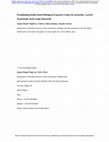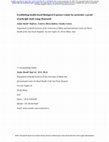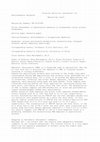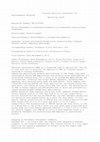Papers by Claudio Colosio
EPIGET Epidemiology, Epigenetics, and Toxicology Lab, Department of Clinical Sciences and Communi... more EPIGET Epidemiology, Epigenetics, and Toxicology Lab, Department of Clinical Sciences and Community Health, Università degli Studi di Milano and Fondazione IRCCS Ca’ Granda Ospedale Maggiore Policlinico, Milan, Italy; Department of Health Sciences of the University of Milan, Laboratory for Analytical Toxicology and Metabolomics (LaTMA) and International Centre for Rural Health of the University Hospital San Paolo, Milan, Italy; Department of Biomedical and Clinical Sciences, University of Milano, and International Centre for Pesticides and Health Risks Protection (ICPS), “Luigi Sacco” Hospital, Milan, Italy
EPIGET Epidemiology, Epigenetics, and Toxicology Lab, Department of Clinical Sciences and Communi... more EPIGET Epidemiology, Epigenetics, and Toxicology Lab, Department of Clinical Sciences and Community Health, Università degli Studi di Milano and Fondazione IRCCS Ca’ Granda Ospedale Maggiore Policlinico, Milan, Italy; Department of Health Sciences of the University of Milan, Laboratory for Analytical Toxicology and Metabolomics (LaTMA) and International Centre for Rural Health of the University Hospital San Paolo, Milan, Italy; Department of Biomedical and Clinical Sciences, University of Milano, and International Centre for Pesticides and Health Risks Protection (ICPS), “Luigi Sacco” Hospital, Milan, Italy

The diagnosis of occupational diseases is based, similarly to any group of diseases caused by exo... more The diagnosis of occupational diseases is based, similarly to any group of diseases caused by exogenous agents, on two components: the identification of the disease affecting the subject (1), and the evaluation of the subsistence of a causal association between the observed disease and a defined occupational exposure (2). A second very important aspect of any environmental-related disease is its preventability, and prevention largely relies on the knowledge of the relationship between exposure and its effects. A third key-aspect is that any occupational disease claims a compensation. Finally, occupational diseases should be properly reported and recorded, in order to collect necessary information to define the burden of disease attributable to specific risk factors, to point out new and emerging risk factors and diseases and to promote preventive interventions. These strongly related components find a fundamental support from the lists of occupational diseases adopted at different levels. Of course, at the basis of the definition of any list of occupational diseases there is the need of reaching an agreement on the criteria for the diagnosis, necessary to ensure consistency in the clinical decisions, to contribute to the management of individual cases and to promote preventive interventions. In substance, in any occupational disease the clinical features must fit in with the current knowledge on the effects consequent to a specific exposure, and exposure levels should be adequate to cause the effect (intensity per duration) as well as the minimum induction time. Finally, the latency period (time elapsed from the beginning of the exposure and onset of the effect) must be consistent with the current knowledge. A very critical issue present in any list addressed both at compensation and at prevention is that the levels of certainty necessary for prevention are significantly lower (precautionary principle) that those necessary to reach a clinical diagnosis

The diagnosis of occupational diseases is based, similarly to any group of diseases caused by exo... more The diagnosis of occupational diseases is based, similarly to any group of diseases caused by exogenous agents, on two components: the identification of the disease affecting the subject (1), and the evaluation of the subsistence of a causal association between the observed disease and a defined occupational exposure (2). A second very important aspect of any environmental-related disease is its preventability, and prevention largely relies on the knowledge of the relationship between exposure and its effects. A third key-aspect is that any occupational disease claims a compensation. Finally, occupational diseases should be properly reported and recorded, in order to collect necessary information to define the burden of disease attributable to specific risk factors, to point out new and emerging risk factors and diseases and to promote preventive interventions. These strongly related components find a fundamental support from the lists of occupational diseases adopted at different levels. Of course, at the basis of the definition of any list of occupational diseases there is the need of reaching an agreement on the criteria for the diagnosis, necessary to ensure consistency in the clinical decisions, to contribute to the management of individual cases and to promote preventive interventions. In substance, in any occupational disease the clinical features must fit in with the current knowledge on the effects consequent to a specific exposure, and exposure levels should be adequate to cause the effect (intensity per duration) as well as the minimum induction time. Finally, the latency period (time elapsed from the beginning of the exposure and onset of the effect) must be consistent with the current knowledge. A very critical issue present in any list addressed both at compensation and at prevention is that the levels of certainty necessary for prevention are significantly lower (precautionary principle) that those necessary to reach a clinical diagnosis
Occupational Health for Health Care Workers, 2018
Occupational Health for Health Care Workers, 2018

Pesticides represent an economical, labor-saving, and efficient tool for pest management, but the... more Pesticides represent an economical, labor-saving, and efficient tool for pest management, but their intrinsic toxic properties may endanger workers and the general population. Risk assessment is necessary, and biological monitoring represents a potentially valuable tool. Several international agencies propose biological exposure indices (BEI), especially for substances which are commonly absorbed through the skin. Biological monitoring for pesticide exposure and risk assessment seems a natural choice, but biological exposure limits (BEL) for pesticides are lacking. This study aims at establishing equivalent biological exposure limits (EBEL) for pesticides using real-life field data and the Acceptable Operator Exposure Level (AOEL) of mancozeb as the reference. This study included a group of 16 vineyard pesticide applicators from Northern Italy, a subgroup of a more extensive study of 28 applicators. Their exposure was estimated using "patch" and "hand-wash" metho...

Pesticides represent an economical, labor-saving, and efficient tool for pest management, but the... more Pesticides represent an economical, labor-saving, and efficient tool for pest management, but their intrinsic toxic properties may endanger workers and the general population. Risk assessment is necessary, and biological monitoring represents a potentially valuable tool. Several international agencies propose biological exposure indices (BEI), especially for substances which are commonly absorbed through the skin. Biological monitoring for pesticide exposure and risk assessment seems a natural choice, but biological exposure limits (BEL) for pesticides are lacking. This study aims at establishing equivalent biological exposure limits (EBEL) for pesticides using real-life field data and the Acceptable Operator Exposure Level (AOEL) of mancozeb as the reference. This study included a group of 16 vineyard pesticide applicators from Northern Italy, a subgroup of a more extensive study of 28 applicators. Their exposure was estimated using "patch" and "hand-wash" metho...
Journal of occupational medicine and toxicology (London, England), 2018
Journal of occupational medicine and toxicology (London, England), 2018

Environmental research, Jan 13, 2018
Penconazole (PEN) is a fungicide used in agriculture. The aim of this work was to evaluate the ex... more Penconazole (PEN) is a fungicide used in agriculture. The aim of this work was to evaluate the exposure to PEN in vineyard workers focusing on urinary biomarkers. Twenty-two agricultural workers were involved in the study; they were investigated during PEN applications and re-entry work, performed for 1-4 consecutive working days, for a total of 42 mixing and applications and 12 re-entries. Potential and actual dermal exposure, including hand exposure, were measured using pads and hand washes. Urine samples were collected starting before the first application, continuing during the work shift, and ending 48 h after the last shift. The determination of PEN in dermal samples and PEN metabolites in urine was performed by liquid chromatography tandem mass spectrometry. Dermal potential body exposure and actual total exposure showed median levels ranging from 18 to 3356µg and from 21 to 111 µg, respectively. Urinary monohydroxyl-derivative PEN-OH was the most abundant metabolite; its exc...

Environmental research, Jan 13, 2018
Penconazole (PEN) is a fungicide used in agriculture. The aim of this work was to evaluate the ex... more Penconazole (PEN) is a fungicide used in agriculture. The aim of this work was to evaluate the exposure to PEN in vineyard workers focusing on urinary biomarkers. Twenty-two agricultural workers were involved in the study; they were investigated during PEN applications and re-entry work, performed for 1-4 consecutive working days, for a total of 42 mixing and applications and 12 re-entries. Potential and actual dermal exposure, including hand exposure, were measured using pads and hand washes. Urine samples were collected starting before the first application, continuing during the work shift, and ending 48 h after the last shift. The determination of PEN in dermal samples and PEN metabolites in urine was performed by liquid chromatography tandem mass spectrometry. Dermal potential body exposure and actual total exposure showed median levels ranging from 18 to 3356µg and from 21 to 111 µg, respectively. Urinary monohydroxyl-derivative PEN-OH was the most abundant metabolite; its exc...









Uploads
Papers by Claudio Colosio